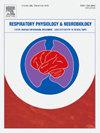慢性阻塞性肺疾病患者呼吸困难的潜在作用:前岛叶皮质和间觉
IF 1.6
4区 医学
Q3 PHYSIOLOGY
引用次数: 0
摘要
呼吸困难(呼吸不适的感觉)对慢性阻塞性肺疾病(COPD)患者来说是一种非常虚弱的症状,并不能完全反映疾病严重程度的生理指标。我们认为,前岛叶皮层(AIC)及其在内感受(体内信号的感知)中的关键作用是呼吸困难症状的重要介质。内感受包括呼吸运动驱动、必然放电、感觉传入、中枢神经整合、错误信号产生、门控、决策处理和行为适应。神经影像学证据支持这一观点,因为慢性阻塞性肺病患者AIC活动下降与呼吸困难加剧有关,而呼吸内感受性注意力任务已被证明可增加大脑该区域的激活。因此,内感受性加工通路中AIC的活性可以解释COPD患者症状负担的一些变异性。我们在当前关于呼吸困难的生理学和神经科学知识的背景下探索这些理论,并借鉴其他呼吸和精神健康状况的内感受性措施的实施。有证据表明,AIC在间感受中起关键作用,并且可能是呼吸困难症状的中介,因此,我们对间感受加工在COPD患者症状负担中的作用的理解,以及测量和治疗的适当方法,应该是研究的重点。本文章由计算机程序翻译,如有差异,请以英文原文为准。
The potential role of the anterior insular cortex and interoception on dyspnea in chronic obstructive pulmonary disease
Dyspnea (the perception of breathing discomfort) can be an immensely debilitating symptom for people with chronic obstructive pulmonary disease (COPD) and is not fully reflective of physiological measures of disease severity. We propose that the anterior insular cortex (AIC) and its key role in interoception (the perception of signals from within the body) are important mediators of dyspnea symptomology. Interoception encompasses respiratory motor drive, corollary discharge, sensory afferents, central neural integration, error signal generation, gating, decision processing and behavioral adaptation. Neuroimaging evidence supports this notion as decreased AIC activity in people with COPD is associated with heightened dyspnea, and respiratory interoceptive attention tasks have been shown to increase activation in this area of the brain. Therefore, activity in the AIC within the interoceptive processing pathway may explain some of the variability in symptom burden in people living with COPD. We explore these theories in the context of the current knowledge on the physiology and neuroscience of dyspnea, drawing on the implementation of interoceptive measures in other respiratory and mental health conditions. Given the evidence that the AIC has a key role in interoception and is a likely mediator within dyspnea symptomology, advances in our understanding of the role of interoceptive processing on symptom burden in people living with COPD, as well as appropriate methods to measure and treat it, should be research priorities.
求助全文
通过发布文献求助,成功后即可免费获取论文全文。
去求助
来源期刊
CiteScore
4.80
自引率
8.70%
发文量
104
审稿时长
54 days
期刊介绍:
Respiratory Physiology & Neurobiology (RESPNB) publishes original articles and invited reviews concerning physiology and pathophysiology of respiration in its broadest sense.
Although a special focus is on topics in neurobiology, high quality papers in respiratory molecular and cellular biology are also welcome, as are high-quality papers in traditional areas, such as:
-Mechanics of breathing-
Gas exchange and acid-base balance-
Respiration at rest and exercise-
Respiration in unusual conditions, like high or low pressure or changes of temperature, low ambient oxygen-
Embryonic and adult respiration-
Comparative respiratory physiology.
Papers on clinical aspects, original methods, as well as theoretical papers are also considered as long as they foster the understanding of respiratory physiology and pathophysiology.

 求助内容:
求助内容: 应助结果提醒方式:
应助结果提醒方式:


